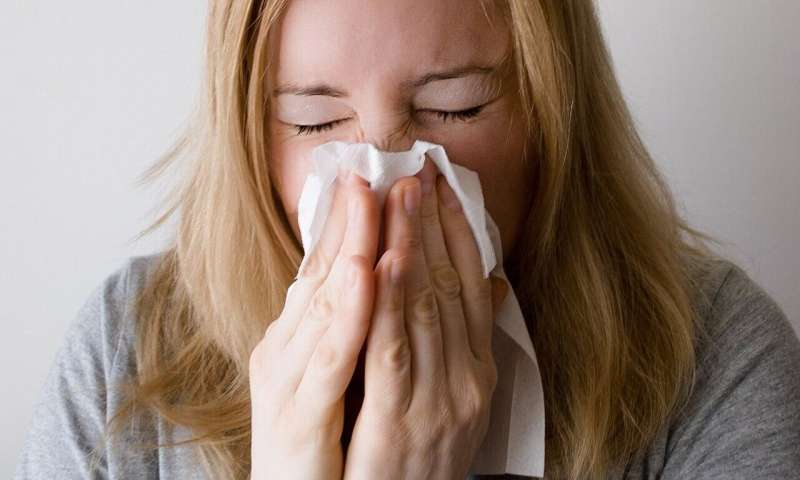This article has been reviewed according to Science X's editorial process and policies. Editors have highlighted the following attributes while ensuring the content's credibility:
fact-checked
reputable news agency
proofread
COVID is surging again this summer in Maryland, hospitalization and wastewater data shows

Judging from local wastewater surveillance trends, President Joe Biden has plenty of company in Maryland as he continues to recover this week from his third bout of COVID-19.
The state is currently seeing the biggest spike in COVID levels in its wastewater—or sewage—since early January, according to data from the U.S. Centers for Disease Control and Prevention. There were "very high" levels of viral activity, nearly double national levels, measured in the state's wastewater as of last week.
Hospitalizations from the virus also have more than doubled in the last month—from 60 on June 22 to 135 on July 22, according to data from the Maryland Department of Health—although they remain far below what they were in January, during what has become an annual winter surge.
At Sinai Hospital in Baltimore, emergency room doctors are seeing a slight spike in patients with COVID, although most have mild—if uncomfortable—symptoms like fever, body aches, vomiting and diarrhea that don't require hospitalization, said Dr. Gregory Cocoran, director of the hospital's emergency department and system director for Lifebridge Health.
But the increase seems unusual for the summer, a season when people typically spend more time outdoors, Cocoran said. He has a theory: It's been so hot lately that people may have preferred to gather inside, where there's air conditioning—and where it's easier for COVID to spread.
"With viruses, there's sometimes a pattern," he said, "and sometimes, there's something that's completely against the expected pattern. And that's, I think, what we're experiencing now.
By now, a fairly consistent cycle has emerged in the yearly spread of COVID. Hospitalizations start trending upward in the late summer, a trend that continues through the fall and winter, until it peaks in early January. Since the start of 2022, when a nasty omicron surge sent thousands to the hospital, each year's peak has been lower than the previous year's peak.
This time last year, there were roughly 80 Marylanders hospitalized with COVID, a number that hit 250 in mid-September, then kept climbing until it reached about 540 in early January.
Dr. Niharika Khanna, a family medicine physician at the University of Maryland Medical Center, said there's been a slight increase in the number of COVID patients she's been seeing, but few report severe symptoms. She remembers seeing a larger increase in patients during last summer's surge.
Khanna and her colleagues don't do many COVID tests anymore. Now, most of their patients test at home, then check in with their primary care doctor in a telehealth appointment. Many just make an appointment to get a doctor's note for work or school, she said.
"The good news is that a lot of them are not sick enough to be sent to the hospital," said Khanna, who is also a professor of family and community medicine at the University of Maryland School of Medicine.
Early in June, the Baltimore City Health Department anticipated a summer increase in COVID cases as people traveled for vacations and gathered with family and friends. Officials launched an ad campaign, encouraging residents—especially older adults—to stay up to date on their COVID vaccines.
"We know that COVID-19 still poses a threat, especially to our most medically vulnerable, including our older adults," Baltimore City Health Commissioner Dr. Ihuoma Emenuga said in a news release announcing the campaign.
"The virus has evolved since the height of the pandemic and just as flu shots are recommended each season, the CDC recommends the updated COVID-19 shots to protect yourself, your loved ones, and your community against serious illness from COVID-19."
In Poolesville—a rural Montgomery County town of about 5,700 people close to the Maryland-Virginia border—Dr. Amar Duggirala, president-elect of the Maryland Academy of Family Physicians and owner of a small private practice, has already put in an order to pharmaceutical company Moderna for the newest batch of vaccines that will likely be available in September.
Like previous years, the CDC is recommending that everyone ages six months and older receive an updated vaccine this fall to protect themselves against the worst effects of COVID.
Research has shown that getting vaccinated reduces risk of hospitalization and death from the virus, as well as developing long COVID—something Duggirala often tells his young and healthy patients to convince them to make time for getting the shot.
Similar to other rural areas, vaccine hesitancy isn't uncommon in Poolesville, and it's definitely gotten worse since the pandemic, Duggirala said. He and his colleagues know their patients. When there's an opening in the conversation where it feels natural to broach the topic of vaccines without making their skeptical patients feel scolded, they jump on it.
Duggirala has changed a few minds over the years, but most remain unmoving.
Still, he said, "we always leave that door open."
2024 The Baltimore Sun. Distributed by Tribune Content Agency, LLC.


















